Otepää, Estonia. Winter is a busy time here for sports as competitors come to this usually sleepy town on Estonia’s southern tip. Sometimes, the scene is exactly what you would expect, like 8,500 bundled-up skiers sliding through town on a cross-country ski trek one weekend last month. Other times, though, you might see a different breed of competitors, one decked out in skimpy bathing suits—or simply in their birthday suits. That’s because Otepää is home to the European Sauna Marathon.
This article was originally written by Liis Kängsepp and published by the Wall Street Journal.
I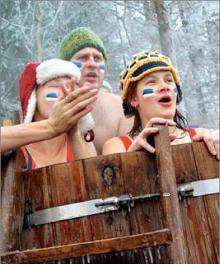 “It is a real Estonian smoke sauna with a sweet and juicy steam,” boasted local businessman Tarmo Tamm, who owns one of the sweltering saunas that dot the unusual competition and are a source of national pride.
“It is a real Estonian smoke sauna with a sweet and juicy steam,” boasted local businessman Tarmo Tamm, who owns one of the sweltering saunas that dot the unusual competition and are a source of national pride.
For the past four years, Otepää has played host to the sauna marathon, where hundreds of competitors sweat to visit as many of the outposts as possible in the shortest time.
The contest has been good for business at Mr. Tamm’s Sokka Holiday Resort, with its cavernous sauna about five miles out of town. He was beaming with pride on a recent Sunday afternoon when the marathon took place. “We finished taking a steam in this sauna last night at half past midnight to have a proper warm-up for today,” he said.
The outdoor temperature had fallen below freezing, but Mr. Tamm was dressed in just a pair of shorts and a white floppy hat with the words “Sauna Boss” embroidered across the front. He recently used an ax to cut through the ice in the pond next to the sauna, making a hole so that “saunalised” competitors could jump into the icy water after their time in the hot room, to win extra points. One sauna tradition is to take the heat then run outdoors and roll around in the snow or take a dip in a pool of ice water.
The sauna marathon should not be confused with the sauna world championships that took place in Finland from 1999 through 2010 and were discontinued after a competitor died and another became sick after sitting too long in extremely hot saunas. The sauna marathon isn’t really an endurance sport.
Estonia’s competition is a race similar to a scavenger hunt in which small groups of contestants race to sit through three-minute stints in a number of saunas—ranging from traditional Finnish saunas to barrel saunas to saunas on wheels—that are scattered about the countryside. Required tools: an orienteering map and an automobile that can accommodate a team of four. Bathing suits are optional.
The event began among friends four years ago and now involves 600 entrants and 20 saunas. The marathon is promoted as a major attraction on Estonia’s official tourism website. Winners win sauna visits.
As the contest has ballooned in size, it has also attracted its share of moneymaking opportunities. For instance, a massive truck made decades ago by a Russian company called ZIL has been converted into a mobile sauna carrying a banner for a company called Lumeabi 24/7, which specializes in shoveling show and chipping icicles off roofs and eaves.
Ulvi Voomets, a 49-year-old information media consultant from the southern town of Antsla, was a member of a squad called Laemma Naaso (which means “Hot Women” in English), four women wearing bathing suits, shower caps and rollers in their hair. They took the crown this year, she says, because of valuable lessons they learned in 2012. “We have drafted a system,” she said, just before jumping into her first sauna of the event.
The team has a designated driver and determines the best route beforehand so members can jump out of the car and run to the saunas, usually not far from the designated parking area. This year, the women wore flip-flops. Last year, they tackled the competition in slippers that became so cold and wet the contestants shed them and ran barefoot.
Not everyone was as prepared as Ms. Voomets this year. A photography student joined three male friends in Otepaa for what she expected to be a cozy, traditional Estonian sauna party among close friends. Which is to say: they were naked. “Who on earth wears clothes to a sauna?” the woman, not wanting to give her name, said as she climbed from a barrel of water heated by burning wood and ran back to a steamy sauna.
In Estonia, the sauna has spiritual roots, having been the place where brides ceremonially washed and women gave birth. It has served as a deathbed for the terminally ill or a healing agent for patients hoping to live. Estonia’s national love affair with the sauna is rivaled only by neighbouring Finland, where “taking a sauna” is like going to lunch or playing a round of golf with business associates.
The sauna has been a gathering place for meetings between power brokers wishing to wheel and deal in an informal and relaxed setting. In 1978, Finnish leaders met in a sauna with Soviet defense officials who wanted to conduct joint military exercises. The Finns used the intimacy of a sauna as a nonthreatening backdrop for deflecting the Soviet proposals.
In 1995, the charismatic Finnish politician Timo Soini met at a lakeside sauna with three colleagues after a thumping defeat in parliamentary elections. “We bathed in the sauna, drank some beer, ate and talked,” Mr. Soini recalled in an interview. The daylong bull session led to the creation of a new party, the nationalistic euroskeptic Finns Party, which has gained considerable popularity in recent years.
Last summer, the 13 men and women who composed the party’s executive committee went back to that retreat, but enjoyed the sauna in separate groups as is typical when an event is arranged by an employer. “You could say we’re conservative on this score,” he said, chuckling.
This collegial atmosphere lives on in the sauna marathon. During the competition, Mr. Tamm was selected for the second straight year as having the best sauna. As hundreds flooded in and out of the sauna, two women played accordions in the dressing room and a man offered garlic-bread and smoked-ham snacks.
His icy swimming hole was the biggest hit. “Cold water against my skin in the winter is something I have never experienced before,” Hector Otero, a Spanish architect living in Estonia, said while warming himself in a bath robe and slipping his feet into rubber sandals. “I would do it again…every winter.”

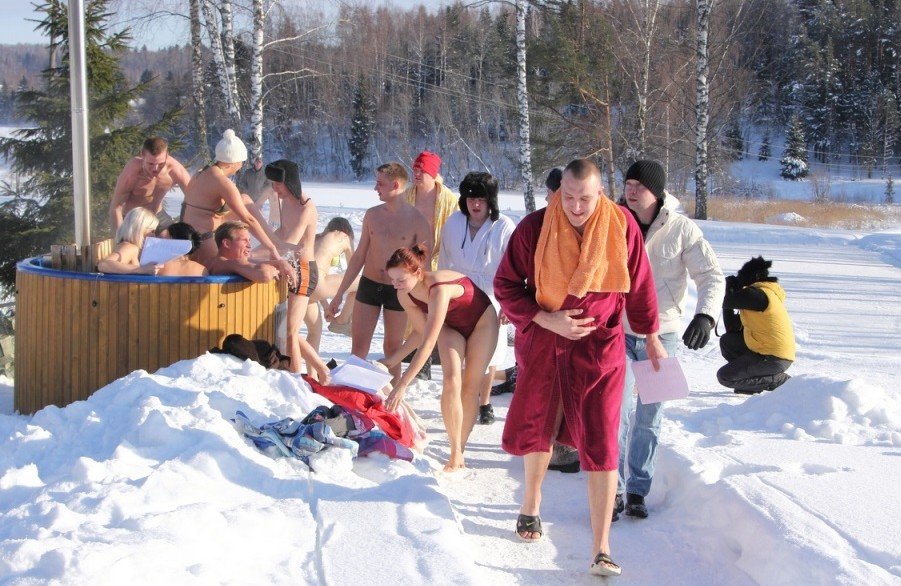
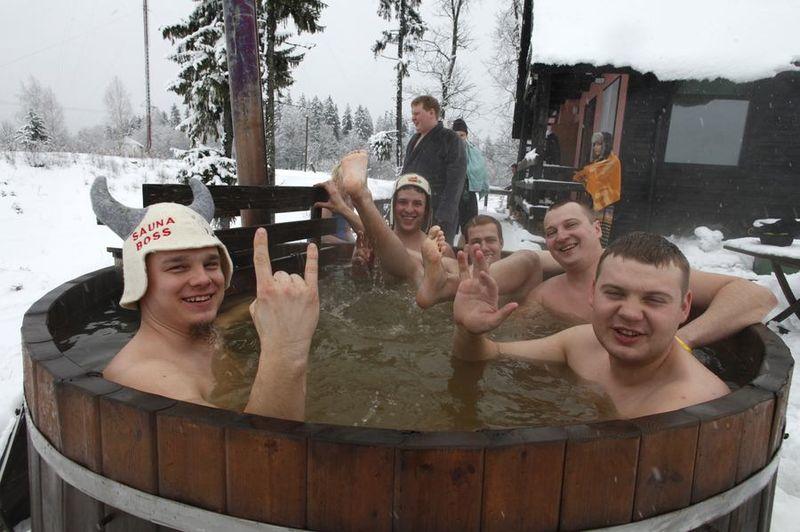

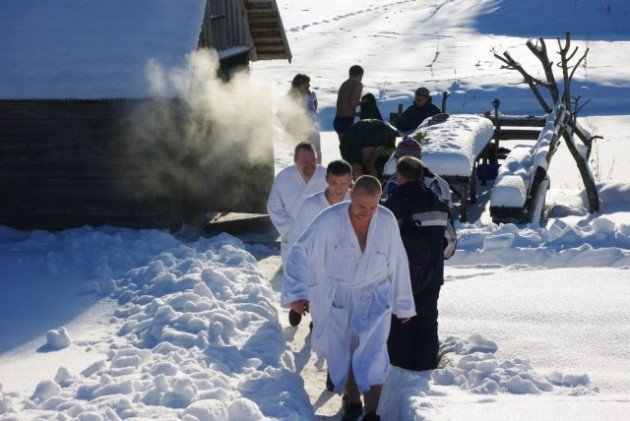
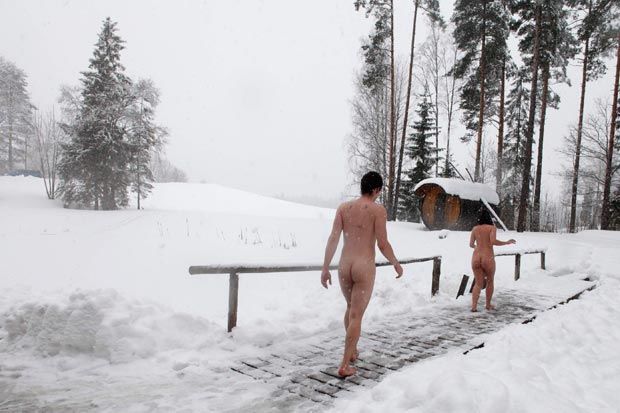
My Florida Finn husband will be so happy to see this. Our air temp this morning 58 unheated pool about 66 we drop our white robes and jump in daily after tennis
there were an italian, one latvian and a spanish… was the only international team during the competition… we have the story 😀
http://tereitalia.altervista.org/tra-pazzi-che-fanno-autostop-mezzi-nudi-di-gaia-zuffa/